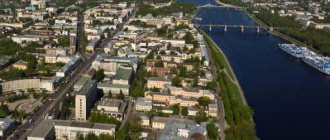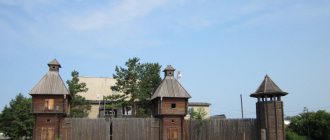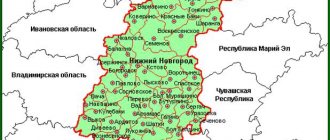How many people live in the city of Tolyatti, what is the population as of January 1, 2022, what number of people live officially, is it increasing or decreasing in municipal areas, growing or vice versa, decreasing, decreasing and where?
Statistics have always interested people and no matter what it concerns, and we are interested in it for a variety of reasons, out of curiosity and for other, very different reasons, we want to know about something, for example, about a given topic, which we will deal with below.
General information and history of Tolyatti
Togliatti is the administrative center of the Stavropol region and one of the largest cities in the Samara region, located directly opposite the picturesque Zhiguli Mountains.
This left bank Volga city had every chance of becoming a typical representative of quiet provincial “settlements”, known only to its indigenous inhabitants. However, today Togliatti is known not only in Russia, but also abroad. And there are several reasons for this.
The first is AvtoVAZ, which, despite many jokes and jokes, to this day remains one of the largest automobile factories in Russia and allows Tolyatti to bear the proud name of the automobile capital.
The second is the population size (according to statistics, Tolyatti is the largest non-capital city in Russia - the so-called sub-millionaire city, which currently has more than 700,000 residents).
The third group consists of talented Togliatti residents (mostly athletes), who brought world fame to the city (Alexey Nemov, Vitaly Groysman, Ilya Bryzgalov, Alexander Gerunov).
And finally, the fourth is a rich history, covered in many secrets and legends. Let's lift the veil of secrecy and begin our acquaintance with the City of the Holy Cross (another unofficial name of Togliatti).
First there was a fortress built by Vasily Tatishchev in 1737 and called Stavropol. Until the 20th century, Stavropol was a very, very modest (even by the standards of that time) settlement with 6,000 inhabitants, one hospital, two hotels and 4 windmills. Therefore, the decision to transform Stavropol into a rural settlement due to economic insolvency, made in 1924, seems quite logical. Stavropol residents regained the right to be called townspeople only 22 years later - in 1946.
The city experienced its rebirth in the early 1950s, when the Council of Ministers of the USSR decided to build a hydroelectric complex on the Volga (Zhigulevskaya HPP). Saving the city from burial under the thickness of the “artificial” sea, Stavropol is moved to a new location and given a new life to it as a dynamically developing industrial city. The Volzhskaya Hydroelectric Power Plant named after Lenin, an electrical engineering plant, a number of chemical enterprises, the Volzhsky Automobile Plant - all this is being built in record time, attracting thousands of young people from all over the country to the “new” Volga city.
Just 20 years after moving to a new location, the population increased 20 times (12,000 residents in the early 1950s and 251,000 citizens in 1970). Then, in the mid-1970s, it was decided to rename Stavropol to Togliatti. Apparently, the name of the Italian communist Palmiro Togliatti seemed to the then leadership of the country more euphonious than Stavropol (translated from Greek as “city of the cross”).
Middle Volga region
As part of the Volga Federal District, its southern part, called the Middle Volga region, is distinguished. On both sides of the longest river in Europe lie the Penza, Ulyanovsk, Saratov and Samara regions, as well as the Republic of Tatarstan. This is where Tolyatti is located. Which region shelters a modern industrial city on the left bank of the Volga? Despite the 18th place in the country in terms of population (more than 712 thousand people) and occupied area (more than 315 square kilometers), Togliatti is not a regional administrative center.
The Middle Volga region is a densely populated and economically developed territory with an advantageous geographical location and developed infrastructure. Convenient transport links have a beneficial effect on the development of the engineering, oil refining, gas and chemical industries for which the region is famous. 74% of the population live in cities. The territory is located in a temperate continental climate zone, where hot summers (+25 ° C) and little snowy winters with sub-zero temperatures (average values are 12-15 degrees below zero) are clearly distinguishable. But there are frosts down to -30 °C. The border with the Lower Volga region passes through the Zhigulevskaya hydroelectric station, where Togliatti is located.
Ecology and climate of Tolyatti
In general, the climate of Tolyatti can be defined as clearly continental. This means that in summer it is hot here (on average +21), and in winter it is quite cold (again, on average -11). The proximity of the Kuibyshev reservoir and the forests separating the city's districts have a beneficial (mitigating) effect on the climate.
Tolyatti in winter
For a long time, Tolyatti residents (especially people of the older generation) determined the weather “according to Moscow” (and, I must say, very successfully). For example, if a sharp cold snap is declared in Moscow today, then in 2 days it’s time to get warmer clothes for the residents of the automobile capital. However, in the last 2-3 years this pattern has been breaking down more and more often. And the weather both in Tolyatti and throughout the Samara region is in most cases determined by the southern regions of our vast homeland.
The ecological situation of the city leaves much to be desired. And if previously the main culprits here were the largest industrial enterprises, shrouding the city in a bluish haze of atmospheric emissions (residents of the Central region suffer especially), today the main source of air pollution is transport (cars account for about 70% of harmful substances emitted into the atmosphere). According to statistics, every third Togliatti resident is a car owner.
Along with vital oxygen, dust, carbon monoxide, sulfur dioxide, nitrogen oxides and volatile organic compounds pass through the lungs of Togliatti residents (to a greater or lesser extent, depending on where they live) every day.
Such a disastrous situation is saved by the introduction of modern wastewater treatment plants into production (thanks to them, industrial pollution in the city has halved over the past 10 years), as well as vast areas of green space within the city and forests outside it.
Samarskaya Luka
The Samara region is located in the middle reaches of the Volga River, where the largest bend (meander), called the Samara Luka, was formed with a coastline of 230 km. It stretches for 60 km from west to east and 30 km from north to south, from the village of Usolye to the city of Syzran. In fact, Samara Luka is washed by the waters of two reservoirs - Saratov and Kuibyshev - and the small Usa River. The answer to the question about Togliatti: “Which region has it in its composition?” - is known to most Russians precisely because the city is located on the banks of the Kuibyshev Reservoir. Kuibyshev was the name of the city of Samara until 1991.
The most picturesque section of the Samara Luka is the distance from Samara to the locks of the Zhigulevskaya hydroelectric power station, the crown of which is the Zhiguli Mountains (height - 375 meters). The river in this place is not wide, and tourists can clearly see how the hill drops steeply towards the Volga. Hydroelectric power stations and mountains are located on the right bank of the river, where the city of Zhigulevsk is located. On the left, at the junction of the low-lying and forest-steppe Trans-Volga region and Samarskaya Luka, Tolyatti stretches (a photo of the city and Samarskaya Luka is presented in the article).
Population of Tolyatti
In terms of the number of people living in the city, Togliatti ranks honorably 19th in Russia (707,408 people as of January 1, 2019). Among non-regional cities, it ranks first.
Of particular note is the Avtozavodsky district of the city, which is the most densely populated area in the Volga region. More than 440 thousand people live on its territory, which is more than 50 percent of the city’s total population. For example, more than 157 people live in the Central District, and 120,000 live in the Komsomolsky District.
This imbalance is caused by the fact that the AvtoVAZ, famous throughout Russia, which produces Lada cars, is located in the Avtozavodsky district. Most of the working population of the area works at this plant.
Togliatti is a unique city. The fact is that it is the only city in the Samara province in which natural population growth has been recorded over recent years. In 2013, in Togliatti, the number of joyful occasions associated with the birth of a child exceeded the number of mourning events associated with the burial of the deceased by approximately 1 thousand.
The main cause of death for Tolyatti residents is diseases of the circulatory system. Over the past year, this disease accounted for 52.4% of deaths. The average age of the deceased was 70.5 years. At the age of 65, Tolyatti residents most often die from malignant neoplasms (17.2%), and at 42, the most common cause of death is injury and poisoning (10%).
Street 70 Let Oktyabrya in Tolyatti
Of the almost 708,000 people living in Togliatti, about 455 thousand people are able to work. 113 thousand city residents have not yet reached the age to earn pocket money. The remaining population enjoys the well-deserved right to rest after several decades of labor exploits. More precisely, they have the right to rest in retirement, but often continue to work even after reaching retirement age. So what to do? After all, the size of the average pension does not inspire optimism.
As for gender distribution, Tolyatti presents a classic picture, very common not only in Russia, but throughout the world - there are more women than men. According to the latest data, almost 388 thousand representatives of the weaker sex and 320 thousand representatives of the stronger sex live in the city.
Today, the average age of a Togliatti resident is 38.4 years, which is slightly lower than this figure in the Samara region (40 years) or in Russia (39 years). Therefore, the slogan “Togliatti is a city of young people!”, which appeared a couple of years ago in the local media, seems completely justified.
The next most important factor determining the “face” of a city is the level of education of the population. Just 20 years ago, almost 85% of Togliatti residents could boast of diplomas from secondary specialized or higher educational institutions. Fortunately, at that time the city had a sufficient number of educational institutions at various levels.
Paradoxically, despite the fact that today the number of schools has increased to 123, and there are about 20 universities, the average Togliatti resident has become less educated. The main problem is that all universities today operate on a commercial basis, and an ordinary factory worker with a salary of 15 thousand rubles a month can hardly afford to pay 70 thousand rubles a year for his child’s education. Of course, there are budget places, but getting into them is extremely difficult (either meeting the right people or a 100-point result on the Unified State Exam will help).
Gender and age
In recent years, the number of residents has remained approximately equal by gender: 45.7% men and 54.3% women. The average life expectancy is 40 years, which is quite low. According to the latest data, 19 people live in Tolyatti who have crossed the 100-year mark.
Women's life expectancy is longer than men's. The number of newborns for the period January-May 2022 decreased by 7% compared to 2022 and amounted to 11,048 citizens.
Districts and real estate of Togliatti
Until recently (namely, 2006), the city of Togliatti included three large districts: Avtozavodsky, Central and Komsomolsky. However, in the summer of 2006, it was decided to also include a number of nearby settlements into the city. We are talking about the village of Novomatyushkino, the urban-type settlements of Fedorovka and Povolzhsky, as well as the village of Zagorodny.
In the spring of 2009, the structure of the administrative-geographical division of Tolyatti became even “slimmer” after the above-mentioned suburban settlements became part of three large districts, receiving the status of microdistricts.
Tolyatti Map
Despite the fact that all three areas are within reach (a trip from one to another takes from 20 minutes to an hour depending on the route chosen), each of them has its own face, its own character and features unique to it. To see this, we suggest taking a virtual tour of the streets and nooks and crannies of each of them.
First on our list is the Avtozavodsky district (more often referred to by Tolyatti residents as “New City”, “Novik” or “Avtograd”), the administrative separation of which took place in 1972. The Avtozavodsky district includes 26 residential blocks located in the so-called “square-cluster method”, i.e. all streets intersect at right angles. In terms of population, the Avtozavodsky district is the undisputed leader not only within Togliatti, but also in the entire Volga region. Today, about 442,000 residents live here.
The face of the new city is the factory workers. Young people 25-35 years old who have dedicated their lives to the Russian automobile industry and every morning at 7 am crowd at city stops waiting for factory routes. Most of them are not burdened with higher education, and therefore they prefer to spend their well-deserved weekends not in libraries, theaters and museums (of which there are about 100 in Tolyatti), but in city parks of culture and recreation or on intra-block alleys. The main condition for a successful evening is a comfortable bench and a couple of bottles of your favorite beer.
For the purpose of “cultivation,” modern “proletarians” visit cinemas from time to time (fortunately, their number in the city has grown noticeably recently - there are separate cinema halls in every major shopping center). Guys and girls who are not burdened with a family would not mind celebrating the end of the work week in a nightclub (there are 17 of them in the city), while married couples prefer a quiet family holiday in a cafe.
Being almost the same age as its inhabitants, the Avtozavodsky district boasts an excellent housing stock. More than 1,300 1,2 and 3-room apartments in relatively new panel and brick houses are waiting for their new owner. Here you can find economy-class housing on the secondary market, where the cost per square meter is about 35,000 rubles, and buy a completely “fresh” apartment in a new building, the square meter of which ranges from 40,000 to 50,000 rubles.
Avtozavodskoy district of the city
The central district (or “Old Town” - by analogy with the “new”) is located directly in the central part of the city (hence the name). In the west, its neighbor is the Avtozavodsky district, and in the east - Komsomolsky. Despite this seemingly territorially advantageous location, the Central District is significantly smaller than the Avtozavodsky District. About 158,000 people permanently live here. However, it is considered to be the administrative center of the city.
On the territory of the Central District there is the building of the city hall and the Togliatti City Duma, the Togliatti Museum of Local Lore, a monument to the founder of the city V.N. Tatishchev, the city museum complex “Heritage”, the memorial complex “City Creators” and many more interesting cultural and architectural monuments telling about the rich history of this Volga city.
Monument to Tatishchev
The condition of the local housing stock fully corresponds to the unofficial name of the area (Old Town). Most of the buildings here were built during the times of Stalin and Khrushchev and since then have practically not undergone major repairs. However, this does not particularly affect the cost of housing. A square meter on the secondary housing market costs an average of 35,000 rubles, in a new building - 45,000 - 47,000.
If the design of the Avtozavodsky district is based on the so-called “square-nested” method, then the Central district is built in accordance with a radial planning system (in the center there is a city park and the central square of the Togliatti cultural center, from which streets diverge to different ends of the district).
A significant part of the Central District is occupied by the private sector, in which dilapidated rickety houses of dandelion grandmothers and luxurious comfortable cottages guarded by a pack of fighting dogs coexist in a bizarre way.
It is traditionally believed that the residents of the “old city” are more intelligent than their neighbors from Avtograd. They more often visit city theaters, museums and art galleries, often visit the Philharmonic and sometimes even look into libraries (in our age of rapidly developing virtual technologies, this cultural object, unfortunately, has every chance of sinking into oblivion).
A real gem of the Central District is the Portovy microdistrict (also known as Portposelok or Portgorod) - “little Switzerland”. Comfortably located on the picturesque Volga bank, it is a real decoration of the city and is traditionally considered one of the most prestigious places in Tolyatti. Luxurious multi-storey cottages immersed in lush greenery of the forest, a beautiful wooden church built with the money of parishioners, an equestrian club and the absence of typical high-rise buildings give this place a special charm. A real “piece of paradise”! True, in order to fully appreciate the beauty of living in this protected area (Port Settlement, being a monument of the socialist era, lays claim to the status of a historical and architectural reserve), you will have to fork out some money. The cost of one hundred square meters of land for building a cottage here ranges from $10,000 to $15,000.
View of Portposelok. Photo by igormo1973 (https://fotki.yandex.ru/users/igormo1973/)
Komsomolsky district (or Komsa) is the smallest of the administrative districts of Tolyatti (only 120,000 inhabitants). Even despite the fact that today it includes 4 microdistricts (the villages of Zhigulevskoye More and Shlyuzovoy, as well as the urban-type villages of Povolzhsky and Fedorovka).
However, the spool is small - but expensive. And its value is, first of all, historical. Created initially on the basis of construction camps, the Komsomolsky district today is an open book telling about the large-scale construction of the Volzhskaya hydroelectric power station in the mid-20th century. On its territory there are important industrial and historical objects. The first include TolyattiAzot, AvtoVAZagregat, Tolyatti River Port, VAZINTERSERVICE, as well as Komsomolsky Meat Processing Plant CJSC. The latter are represented by St. Tikhon's Church and the Annunciation Skete, built in the mid-19th century.
The Shlyuzovaya microdistrict (or rather, one of its blocks, which local residents lovingly call “little Petersburg”) deserves special attention. It seems that life here stopped many years ago. Instead of noisy highways there are narrow streets, instead of high-rise buildings there are low-rise Khrushchev and Stalin buildings, and instead of supermarkets there are good old Soviet stores with saleswomen in white caps at the counter. However, despite such an idyllic picture, real estate in the Komsomolsky district is not in high demand. After admiring the wonderful buildings of Soviet classicism, most Togliatti residents happily return to their comfortable apartments in new areas.
Courtyard of the Shlyuzovaya microdistrict
Territory, administrative structure
Today Togliatti, a photo of which you can see on the page, occupies an area of about 315 square meters. km, 25.5% of it is urban forests. This is the greenest city in the Samara region. There are significant distances between its three administrative districts, stretched along the Volga for 40 km. 36% of the city territory is occupied by the Avtozavodskoy district, where the AvtoVAZ premises are located. It is separated from Central by 3 km of forests. The Komsomolsky district is another 5–7 km away. In terms of area, it, like Central, occupies 32% of the entire city territory.
Since its founding, the city has had its own coat of arms in the form of a fortress with a cross in the middle. The head of the executive branch is the mayor; today this post is occupied by S.I. Andreev. Legislative power is concentrated in the hands of the Tolyatti City Duma, consisting of 35 deputies. In October 2015, Tolyatti (Samara region) received the status of a single-industry town, since the social well-being of the majority of residents depends on the situation at the main enterprise of the region - AvtoVAZ.
City infrastructure
Tolyatti, as a city that strives for 1 million inhabitants, has a well-functioning infrastructure. However, this is not without problems.
The main source of headaches is the housing and communal services, which, as in the pre-reform period, continues to surprise city residents with the constant increase in tariffs and the amounts indicated on receipts coming from nowhere. Today, it is probably impossible to find a person satisfied with the work of the housing and communal services. Memories are still fresh of the transition period, when people received two receipts for utility bills, and a few months later they were warned of prosecution for failure to pay one of the receipts.
Tolyatti management companies service 9,757 residential buildings, which contain 219.1 thousand apartments with a total area of 14,482.7 thousand m2. 90% of this housing is privately owned. 88.2% of apartments in multi-apartment buildings have been privatized.
The largest number of buildings (5,959) are located in the Central District. There are 2,768 buildings in the Komsomolsky district. Despite the fact that the Avtozavodsky district is the largest not only in the city, but in the entire Volga region, there are “only” 891 buildings on its territory.
The vast majority of buildings in Togliatti have 1 or 2 floors (7,378). In second place are 6-, 9- and 10-story buildings. There are 708 of them in the city. Also in Togliatti there are 656 5-story, 491 3- and 4-story, 259 12-story and higher-rise buildings.
Tolyatti has not escaped the eternal problem of bad roads. Every spring, city roads look as if they have been carpet bombed. The pits are simply terrifying in size. Considering that storm drains have not been able to cope with their task for many years, holes hidden under water pose a serious threat to motorists. It is difficult to say what this is connected with, but in 2012 the number of lawsuits against organizations responsible for the condition of the roadway increased sharply. Interestingly, all these claims were satisfied and the injured car owners received the necessary compensation.
Of course, roads are being repaired, but not at the same rate as they are being worn out. The municipality is trying to deal with potholes using pothole repair, but as the authorities themselves admit, this is just a temporary emergency option that helps to somehow normalize traffic on the road and wait for serious repairs, including replacing the entire road surface.
In addition to potholes, it is also worth noting road markings, which are washed off the road surface every spring along with melted snow.
The deplorable condition of the roads, the lack of driving culture among most local drivers and the ever-growing number of cars often lead to accidents. Since many roads in Tolyatti are simply not designed to handle large traffic flows, one stalled car is enough to create a traffic jam several hundred meters long. During rush hour, when people are rushing home after a hard day at work, such a nuisance can completely paralyze traffic on a particular street.
One gets the impression that the city architects, when creating road junctions and intra-block passages, could not even imagine that in a city where tens of thousands of cars are produced annually, one day almost every family would have a car.
Tolyatti residents who have not yet become owners of their own means of transportation move around the city by public transport. Today in Togliatti there are 49 bus and 22 trolleybus routes. As for minibus taxis, it is quite difficult to calculate the exact number of their routes. Today there are about 100 of them. The bus and trolleybus fleet is constantly being updated, and the Gazelles are gradually being replaced by much more comfortable foreign-made minibuses.
Everyone knows that theater begins with a coat rack, and the struggle for intelligence begins with school. Historically, Tolyatti schools are used as a platform for introducing various innovative ideas and testing the latest developments in the field of secondary school education.
Today in Tolyatti there are about 100 secondary schools, with 66,117 students. 3,639 teachers are trying to impart knowledge into them. And sometimes quite successfully.
Geographical position
It is located 70 km upstream of the Volga River relative to the capital of the Samara region. The length of the borders is 149 km. The city is not part of the Stavropol region and, in addition to it, borders on Zhigulevsk. The issue of connecting these two cities has been discussed for a long time, but so far this is just a project. From the south the city connects with the dam of the Kuibyshev Reservoir, from the east it is surrounded by forests, and from the north-west by agricultural land.
Tolyatti on the map of Russia can be found at the following coordinates:
- 53° 31′ north latitude;
- 49° 25′ east longitude.
The city is located in the Samara time zone. Its offset relative to Moscow time is +1 hour. The region is in daylight saving time, which also results in a shift relative to UTC.
Enterprises and work in Tolyatti
Just a few years ago, Tolyatti was one of the most prosperous Russian cities from an economic point of view. The well-known Forbes magazine, compiling a ranking of the most attractive Russian cities for business, in 2008 gave Togliatti a very honorable 5th place, and called the city itself the largest economic and industrial center, which plays an important role not only in the economy of the region, but also the country as a whole.
Unfortunately, today the situation has changed significantly. And not at all for the better. The global financial crisis has taken a toll on the Tolyatti economy. Therefore, the once prosperous city with ambitious plans is now again forced to conquer lost positions.
The city-forming enterprise of Tolyatti is the Open Joint-Stock Company "AVTOVAZ" - a plant specializing in the production of LADA passenger cars. Today, more than 66,000 people work here, including about 5,000 temporary workers. A full package of social guarantees, stability, a clearly fixed working day and the opportunity to “work hard” from time to time - all this makes the plant still the most attractive workplace for Togliatti residents.
AvtoVAZ
Also on the territory of Togliatti there are several other large enterprises in the engineering industry. This is "GM-AVTOVAZ" - an automobile plant, which is the fruit of the joint work of Togliatti residents and their American colleagues, the group, which is a large industrial holding company specializing in the production of a wide range of various products (from automotive to defense), "Detalstroykonstruktsiya", "Johnson" Control Togliatti" - a plant for sewing covers for cars, "VazInterService" - a company supplying components to car assembly plants in Russia and abroad, and "AvtoVAZagregat".
The list of large industrial facilities in the city continues with two combined heat and power plants - the Volzhsky Automobile Plant CHP Plant and the Togliatti CHP Plant - and an impressive group of chemical industry enterprises. The latter is represented by TogliattiAzot, the world’s largest ammonia production plant, KuibyshevAzot, specializing in the production of mineral fertilizers, and Togliattikauchuk, a plant producing synthetic rubber.
It is also worth noting the dynamically developing food industry (the city has its own meat processing plants, dairy and bakeries, a distillery, a champagne and cognac plant, a winery), enterprises specializing in the production of electrical equipment, factories producing plastic and rubber products and other types of industrial production.
The banking sector is well developed, there are many insurance companies that take an active part in the economic life of Tolyatti. Small businesses are doing well.
It would seem that a city with so many large industrial facilities is simply doomed to prosperity. However, for the past few years, Tolyatti residents have been living in constant fear - “What does the coming day have in store for us?” After mass layoffs during the crisis years, the myth about the stability of work “at the bench” was finally dispelled. And wages still cannot recover from the shock and reach at least the pre-crisis level.
There are lively “discussions” taking place in the local press and at large city forums (of course, if this definition can be applied to the dialogue between statements of the federal authorities and ordinary Togliatti residents). The reason for the indignation of Avtograd residents is the greatly inflated official statistics, according to which the average monthly salary in the city is about 20,000 - 21,000 rubles. This is understandable. After all, an ordinary factory worker (and these are the majority at AvtoVAZ) receives an average of 11-13 thousand rubles per month, an employee of Togliattikauchuk - about 12 thousand, teachers - 8-10 thousand rubles, managers of car dealerships and travel agencies - 12,000-15,000 rubles, and salespeople, cashiers, operators and other employees of federal retail chains (of which there are a great many in the city) – no more than 15,000. It doesn’t even smell like 20 thousand...
And here we must say thank you to the small, but so important for the extras, leadership team, hiding, like secret agents, in the cozy offices of the VAZ high-rise building. It is thanks to these soldiers of the invisible front with official salaries of several million rubles that the standard of living of Togliatti residents “on average” looks very decent!
AvtoVAZ office
Avtozavodskoy district
Residents distinguish between themselves the territory of the New and Old Towns. The first includes the Avtozavodskoy district, the population of which significantly exceeds the total number in the other two and amounts to more than 436 thousand inhabitants. It occupies the western part of the city, overlooking the banks of the Volga. Its structure is divided into 28 blocks, inside of which there are parks and boulevards. Major roads separate the neighborhoods from each other. But such development is not typical for all of Togliatti, the map of which gives an idea of the characteristics of each administrative district. In addition to AvtoVAZ, it is on the territory of the New City that light industrial enterprises known in the region are located: a champagne wine factory, a dairy factory and a clothing factory.
This is the youngest area, the housing stock of which began to be built simultaneously with the construction of the automobile plant. And the only one where the birth rate exceeds the death rate. New houses are being built right in the forest area, expanding the boundaries of the city.
Crime
- Hello! We are from Tolyatti. - Why are you threatening right away?!
Togliatti became the unofficial criminal capital back in the dashing 90s and has not yet lost this dubious glory. It was in Togliatti that 20 years ago there were fierce wars between organized criminal groups, the victims of which, unfortunately, were not only members of various organized crime groups, but also ordinary civilians. And today, city guests sometimes specially come to the city cemetery to look at the so-called “alley of heroes”, where crime bosses and members of their gangs are buried.
Why was Togliatti attractive to criminal elements of all stripes, and what was the reason for the real massacre that took place in the city in the early 1990s? The answer is simple - it is AvtoVAZ.
It all started back in the 80s with the banal theft of auto parts, which were in great short supply in those days. Of course, we are not talking about carrying parts in trouser pockets or throwing boxes of spare parts over the factory fence. C, loaded with stolen parts. 10 years later, organized crime groups, which had already divided the city into spheres of influence, launched a real war to establish control over AvtoVAZ. No one could even think that the city would have to endure three waves of violence associated with the struggle for criminal supremacy in Tolyatti.
The bandits were well aware that huge amounts of money were circulating at VAZ, but for the time being the only thing they succeeded in doing was robbing car buyers outside the plant. This was not enough. It all started with the occupation of factory checkpoints and the Zhiguli store, the only official factory store in Tolyatti.
In 1992, bandits began to control the shipment of cars from the plant. This business turned out to be the most profitable. Using a scheme developed by Vladimir Bilichenko, organized criminal groups drove away about 30 thousand cars annually. This is too tasty a morsel for everything to go quietly and peacefully. The first conflicts began to arise between the factions.
The first Great Racketeer War began. It was initiated by the “Agievskaya” organized crime group led by Vladimir Agiy and Alexander Voronetsky, who decided to take AvtoVAZ under their sole control. To implement their plans, they turned to Oleg Khoroshev’s gang, nicknamed “Podarok”, which agreed to shoot competitors for a substantial reward.
The first target of the “Agiyev” group was the former thimblemaker Vladimir Vdovin, nicknamed “Partner,” who headed the “Partner” organized crime group. By mid-1992, Vdovin had practically taken over the Zhiguli store. Despite all efforts, none of the attempts was successful. After this, the “Agievskys” switched their attention to the leaders of the “Kupeyevskaya” group, Sergei and Garry Kupeev. However, the Kupeev brothers were also too tough for them. The next target of the Agievskys was Vladimir Bilichenko, who failed to survive the assassination attempt. From that moment on, bloody showdowns between organized criminal groups began.
The first war lasted more than a year. As a result, the criminal world lost such authoritative bandits as Vladimir Bilichenko, Sergey Kupeev, Alexander Maslov, Alexander Voronetsky, Vladimir Dorovskikh “Sivy”. Some of the bandits went missing. Instead of Maslov, Dmitry Ruzlyaev, nicknamed “Dima Bolshoi,” became the head of the “Volgov” organized crime group. The maximum benefit from this war was received by Vdovin, who, remaining the only representative of the “old guard,” rose to the very top of the Tolyatti criminal hierarchical ladder. Without his participation, not a single serious issue was resolved in the city.
Vladimir Vdovin
As a result of the subsequent two wars between organized crime groups, almost all authoritative bandits were either killed or imprisoned for long periods. Over 10 years of conflict, more than 500 people associated with the criminal world died. The only person who managed to go through all the showdown and stay alive is Vladimir Vdovin, nicknamed “Partner”. Today he has retired and lives in one of the European countries.
Komsomolsky district
About 120 thousand people live in the easternmost region, located directly on the banks of the Volga downstream. It is adjacent to the Zhigulevskaya hydroelectric power station dam and goes directly onto the M5 federal highway. It is here that the river port of the city is located, where tourists traveling along the Volga stop. The most beautiful embankment is the real pride of the area, whose production enterprises are located at a considerable distance from residential buildings: TogliattiAzot, AvtoVAZagregat, VAZINTERSERVICE.
Previously, the village of Kuneevka was located on the territory of the district, so the private sector and buildings from the 50s have been preserved for a long time. Despite the excellent location of the area, real estate here is not in great demand. Residents prefer to travel from 20 to 60 minutes, but live in more comfortable houses. This part of Tolyatti (the city map gives an idea of the area) belongs to the historical values of the metropolis. The 19th century churches are located here: St. Tikhon’s and Annunciation monasteries. The Shlyuzovaya microdistrict (former village) is called mini-Petersburg due to its buildings in the classicist style.
Highlights from history
The Orenburg expedition led by V. Tatishchev marked the beginning of the history of this place in 1737. The Stavropol fortress, formed in 1739, was intended to protect the population. Kalmyks arrived every year to serve in the Stavropol garrison, and the soldiers actively introduced them to agriculture.
Faith in Christ was strengthened with great difficulty in these territories among the Kalmyks, who were left here for permanent residence.
The second important moment in its development was the construction of a hydroelectric power station. Construction of the hydroelectric complex, valuable for the state, began in 1950. As a result, the level of the Volga was raised and a reservoir was formed.
This had a detrimental effect on the settlement itself; it actually completely ended up at the bottom. Then the settlement was moved to the left bank of the Volga, 18 km from the hydroelectric station. Gradually, the city grew and blossomed into the national capital of the automobile industry.
Attractions. How to get there?
The city attracts tourists due to its proximity to the Zhiguli Mountains. Every year, on the first Sunday in July, art song lovers gather in the vicinity of Tolyatti for the Grushinsky Festival (new name - “Platform”). Hundreds of thousands of participants come to the Mastryukov Lakes, where songs by talented performers from all over Russia are heard in memory of the deceased Valery Grushin. Therefore, many people have a question: “Where is Togliatti, which region of Russia organizes the festival of bard song?”
The most convenient way to get to the city is by air. Kurumoch International Airport is 50 km away, with regular buses and taxis. It is important to decide which part of the city a person needs to get to: New or Old, because these are completely different routes. In summer, it is easy to get to the city by water, taking a fascinating walk along the Volga. You can also get there by rail, but the main railway junction is not in Tolyatti. The map will help you decide on a train to Samara, the capital of the region, from where there are regular buses, intercity minibuses and taxis.









